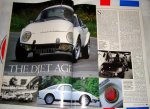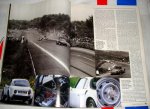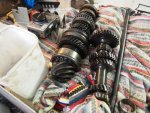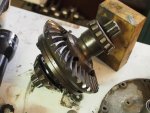Jean Redele vs Rene Bonnet. (Alpine vs Matra.)
This is my version of 2 very similar cars of the same era by 2 individuals that had so many similarities but with completely different end results.

Because all of us here are familiar with the Alpine A110, I will elaborate more on the Matra Djet of which I knew nothing until a couple of years ago. I have since stripped one completely and re-assembled it as well. Most of this is factual although there are a few things that I assumed through common sense. Feel free to correct me if I’m wrong.
Rene Bonnet had this idea, or vision, in his mind that if a Formula 1 car is the pinnacle of race cars, “why can’t I put a body around one and make it a road car”? (This was the beginning of the mid-engine F1 cars, the Lotus and Jim Clark era when front engine F1 cars were completely overshadowed). So he did, creating the first ever true mid-engine car in 1962 beating De Tomaso with a year. After De Tomaso the Ferraris and Lamborghinis etc followed. The Matra came complete with double wishbone rear suspension and a type of CV joint driveshaft. This layout remained until the last Matra Jet was built in 1968.

Rene Bonnet was building his cars using anything he could lay his hands on and maybe for the best price as well. During my restoration process I noted the following: from Renault R8: front suspension, disc brakes, rack and pinion, engine, instrumentation. Renault Estafette: Gearbox. Renault Caravelle: door handles inside and outside, window winders. Peugeot: ash tray, clutch slave cylinder, Citroen: window washer. Simca: tail lights, windscreen wiper mechanism.
Around 1964 his debts hauled him in. A brilliant engineer but a not so good business man, he owed MATRA (Mécanique Aviation TRAction) a lot of money as he rented some space in their building and they manufactured the bodies for his cars as well. They decided to buy him out instead of closing the shop. From then on it was named Matra. They had access to Renault engines until 1968 when Renault decided to pull the plug on Matra and support Redele in the Alpine. At least Redele’s father had a Renault agency and Matra was just another car manufacturer and opposition. For Renault it wouldn’t have been good practise if Matra was going to be competition for Alpine. After this decision, Matra sat with a big engine problem for their new model, the Matra 530 and all they could find was the German Ford V4 engine that was a poor performer. The performance of the new model dropped from a top speed of 210 km/h of the Jet to 175 km/h for the 530. Other performance figures for the Jet 6 was 0-60 mph in 8.5 sec and the ¼ mile in 16.8 sec. It was only a few years later when Simca came on board.
To compare the 2 cars will be difficult because I might ruin some friendships. That is not my intention. It might be seen as sour grapes, jealousy or just wishful thinking because in fact the A110 has become THE car to own, and I will be lying if I say that I don’t want an A110. However, have a look at the technical differences and compare it with what we know today and when only these differences were applied to the A110.
In total, there were only 1500 Djets/Jets manufactured. I think the A110s exceeded the 9000 figure.
Similarities:
1) Front suspension is identical. Both cars are using the R8 front double wish bone layout.
2) Rack and pinion. R8 quick ratio.
3) Tubular backbone chassis layout.
4) Engines, mostly used was the Sierra 1108, 1300 then Gordini 1100 and 1255.
5) Bodies, made of Fibreglass or various other names used for the same stuff.
6) Brakes, to a certain extent.
In summary the main and very important technical differences between the two cars from my experience of working on both:
1) The main difference is the engine lay out. It is a mid-engine layout that is mounted directly behind the driver. This is a superior advantage which is proven through the years and all super cars (except Porsche 911) are built on this principal today. This means that the weight distribution between front and rear is 48/52 %. Have a look at the brand new A110-50 that has a similar weight distribution as the Matra, but it came about 55 years later.
2) Rear suspension. It is their own unique design that incorporates a double wishbone system. Double coils and double shocks were used. The drive shafts are not in a tube but open with U-joints on the inner and outer sides. At the time CV joints were not available, or designed, so the sideward play of the engine on its mountings were absorbed by the sliding splines in the shafts.
3) Brakes: The Renault R8 disc brakes were used until 1966 when it was upgraded to the “big brakes” available at the time on the front wheels. In 1967 they were using the R16 brakes because the 16TS was only released in 1969 but the upgrade was done immediately.
4) Cooling: The cooling system incorporated a front mounted radiator from the initial design in 1962 with an electrical cooling fan.
That concludes a bit of detail that wasn't known to me and I place it here with good intent.
Regards, Frans
This is my version of 2 very similar cars of the same era by 2 individuals that had so many similarities but with completely different end results.

Because all of us here are familiar with the Alpine A110, I will elaborate more on the Matra Djet of which I knew nothing until a couple of years ago. I have since stripped one completely and re-assembled it as well. Most of this is factual although there are a few things that I assumed through common sense. Feel free to correct me if I’m wrong.
Rene Bonnet had this idea, or vision, in his mind that if a Formula 1 car is the pinnacle of race cars, “why can’t I put a body around one and make it a road car”? (This was the beginning of the mid-engine F1 cars, the Lotus and Jim Clark era when front engine F1 cars were completely overshadowed). So he did, creating the first ever true mid-engine car in 1962 beating De Tomaso with a year. After De Tomaso the Ferraris and Lamborghinis etc followed. The Matra came complete with double wishbone rear suspension and a type of CV joint driveshaft. This layout remained until the last Matra Jet was built in 1968.

Rene Bonnet was building his cars using anything he could lay his hands on and maybe for the best price as well. During my restoration process I noted the following: from Renault R8: front suspension, disc brakes, rack and pinion, engine, instrumentation. Renault Estafette: Gearbox. Renault Caravelle: door handles inside and outside, window winders. Peugeot: ash tray, clutch slave cylinder, Citroen: window washer. Simca: tail lights, windscreen wiper mechanism.
Around 1964 his debts hauled him in. A brilliant engineer but a not so good business man, he owed MATRA (Mécanique Aviation TRAction) a lot of money as he rented some space in their building and they manufactured the bodies for his cars as well. They decided to buy him out instead of closing the shop. From then on it was named Matra. They had access to Renault engines until 1968 when Renault decided to pull the plug on Matra and support Redele in the Alpine. At least Redele’s father had a Renault agency and Matra was just another car manufacturer and opposition. For Renault it wouldn’t have been good practise if Matra was going to be competition for Alpine. After this decision, Matra sat with a big engine problem for their new model, the Matra 530 and all they could find was the German Ford V4 engine that was a poor performer. The performance of the new model dropped from a top speed of 210 km/h of the Jet to 175 km/h for the 530. Other performance figures for the Jet 6 was 0-60 mph in 8.5 sec and the ¼ mile in 16.8 sec. It was only a few years later when Simca came on board.
To compare the 2 cars will be difficult because I might ruin some friendships. That is not my intention. It might be seen as sour grapes, jealousy or just wishful thinking because in fact the A110 has become THE car to own, and I will be lying if I say that I don’t want an A110. However, have a look at the technical differences and compare it with what we know today and when only these differences were applied to the A110.
In total, there were only 1500 Djets/Jets manufactured. I think the A110s exceeded the 9000 figure.
Similarities:
1) Front suspension is identical. Both cars are using the R8 front double wish bone layout.
2) Rack and pinion. R8 quick ratio.
3) Tubular backbone chassis layout.
4) Engines, mostly used was the Sierra 1108, 1300 then Gordini 1100 and 1255.
5) Bodies, made of Fibreglass or various other names used for the same stuff.
6) Brakes, to a certain extent.
In summary the main and very important technical differences between the two cars from my experience of working on both:
1) The main difference is the engine lay out. It is a mid-engine layout that is mounted directly behind the driver. This is a superior advantage which is proven through the years and all super cars (except Porsche 911) are built on this principal today. This means that the weight distribution between front and rear is 48/52 %. Have a look at the brand new A110-50 that has a similar weight distribution as the Matra, but it came about 55 years later.
2) Rear suspension. It is their own unique design that incorporates a double wishbone system. Double coils and double shocks were used. The drive shafts are not in a tube but open with U-joints on the inner and outer sides. At the time CV joints were not available, or designed, so the sideward play of the engine on its mountings were absorbed by the sliding splines in the shafts.
3) Brakes: The Renault R8 disc brakes were used until 1966 when it was upgraded to the “big brakes” available at the time on the front wheels. In 1967 they were using the R16 brakes because the 16TS was only released in 1969 but the upgrade was done immediately.
4) Cooling: The cooling system incorporated a front mounted radiator from the initial design in 1962 with an electrical cooling fan.
That concludes a bit of detail that wasn't known to me and I place it here with good intent.
Regards, Frans






